
|
U. S. CIVIL WAR
PHOTOGRAPHS
|

|
SHILOH
(PITTSBURG LANDING)
(PAGE 1 OF 8)

Primary Text Source: U.S. Gov't, National Park Service.
In the text, the icon  is a link to the definition of the word it marks. is a link to the definition of the word it marks.
Use your
browser's "back" button to return to the page.
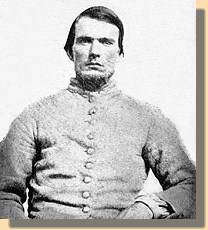 116 116
Pvt. Sampson Altman, Jr.
Company C, 29th Regiment,
Georgia Volunteers, C.S.A.
Pvt. Altman fought in the battle of Shiloh.
He died April 23, 1863 from disease.
| |
April 6-7, 1862
Estimated Casualties : 23,746 total
(US 13,047; CS 10,699) : 23,746 total
(US 13,047; CS 10,699)
As a result of the fall of Forts Henry and
Donelson, Confederate Gen.
Albert Sidney Johnston, the commander in the area, was forced to fall back,
giving up Kentucky and much of West and Middle Tennessee. He chose Corinth,
Mississippi, a major transportation center, as the staging area for an
offensive against Maj. Gen. Ulysses S. Grant and his Army of the Tennessee before
the Army of the Ohio, under Maj. Gen. Don Carlos Buell, could join it.
The Confederate retrenchment was a surprise, although a pleasant one, to the
Union forces, and it took Grant, with about 40,000 men, some time to mount a
southern offensive, along the Tennessee River, toward Pittsburg Landing. Grant
received orders to await the Buell's Army of the Ohio at Pittsburg Landing. Grant
did not choose to fortify his position; rather, he set about drilling his men
many of which were raw recruits. Johnston originally planned to attack Grant on
April 4, but delays postponed it until the 6th. Attacking the Union troops on the
morning of the 6th, the Confederates surprised them, routing many. Some
Federals made determined stands and by afternoon, they had established a
battle line at the sunken road, known as the "Hornets Nest." Repeated Rebel
attacks failed to carry the Hornets Nest, but massed artillery before
the Army of the Ohio, under Maj. Gen. Don Carlos Buell, could join it.
The Confederate retrenchment was a surprise, although a pleasant one, to the
Union forces, and it took Grant, with about 40,000 men, some time to mount a
southern offensive, along the Tennessee River, toward Pittsburg Landing. Grant
received orders to await the Buell's Army of the Ohio at Pittsburg Landing. Grant
did not choose to fortify his position; rather, he set about drilling his men
many of which were raw recruits. Johnston originally planned to attack Grant on
April 4, but delays postponed it until the 6th. Attacking the Union troops on the
morning of the 6th, the Confederates surprised them, routing many. Some
Federals made determined stands and by afternoon, they had established a
battle line at the sunken road, known as the "Hornets Nest." Repeated Rebel
attacks failed to carry the Hornets Nest, but massed artillery helped to turn
the tide as Confederates surrounded the Union troops and captured, killed, or
wounded most. Johnston had been mortally wounded earlier and his second in
command, Gen. P.G.T. Beauregard, took over. The Union troops established
another line covering Pittsburg Landing, anchored with artillery and augmented
by Buell's men who began to arrive and take up positions. Fighting continued
until after dark, but the Federals held. By the next morning, the combined
Federal forces numbered about 40,000, outnumbering Beauregard's army of less
than 30,000. Beauregard was unaware of the arrival of Buell's army and launched
a counterattack in response to a two-mile advance by William Nelson's division helped to turn
the tide as Confederates surrounded the Union troops and captured, killed, or
wounded most. Johnston had been mortally wounded earlier and his second in
command, Gen. P.G.T. Beauregard, took over. The Union troops established
another line covering Pittsburg Landing, anchored with artillery and augmented
by Buell's men who began to arrive and take up positions. Fighting continued
until after dark, but the Federals held. By the next morning, the combined
Federal forces numbered about 40,000, outnumbering Beauregard's army of less
than 30,000. Beauregard was unaware of the arrival of Buell's army and launched
a counterattack in response to a two-mile advance by William Nelson's division of Buell's army at 6:00 am, which was, at
first, successful. Union troops stiffened and began forcing the Confederates
back. Beauregard ordered a counterattack of Buell's army at 6:00 am, which was, at
first, successful. Union troops stiffened and began forcing the Confederates
back. Beauregard ordered a counterattack , which stopped
the Union advance but did not break its battle line. At this point, Beauregard
realized that he could not win and, having suffered too many casualties, he
retired from the field and headed back to Corinth. On the 8th, Grant sent Brig.
Gen. William T. Sherman, with two brigades , which stopped
the Union advance but did not break its battle line. At this point, Beauregard
realized that he could not win and, having suffered too many casualties, he
retired from the field and headed back to Corinth. On the 8th, Grant sent Brig.
Gen. William T. Sherman, with two brigades , and Brig. Gen. Thomas J. Wood, with his
division, in pursuit of Beauregard. They ran into the Rebel rearguard, commanded
by Col. Nathan Bedford Forrest, at Fallen Timbers. Forrest's aggressive tactics,
although eventually contained, influenced the Union troops to return to Pittsburg
Landing. Grant's mastery of the Confederate forces continued; he had beaten them
once again. The Confederates continued to fall back until launching their
mid-August offensive. , and Brig. Gen. Thomas J. Wood, with his
division, in pursuit of Beauregard. They ran into the Rebel rearguard, commanded
by Col. Nathan Bedford Forrest, at Fallen Timbers. Forrest's aggressive tactics,
although eventually contained, influenced the Union troops to return to Pittsburg
Landing. Grant's mastery of the Confederate forces continued; he had beaten them
once again. The Confederates continued to fall back until launching their
mid-August offensive.
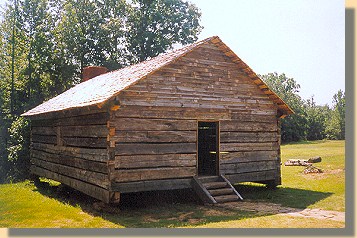
Re-constructed Shiloh Church
The Battle of Shiloh takes its name from a Methodist log church that stood during
the battle. On the morning of Sunday, April 6, 1862, Brig. Gen. William T.
Sherman, commander of the Fifth Division of the Union Army of the Tennessee,
and his men were camped near Shiloh Church when surprised and assailed by the
Confederates.
For two days, the armies of North and South clashed in the fields and forests
surrounding Shiloh Church.
The original log meeting house was erected in 1853. The building survived the
battle to serve as a hospital, but collapsed several weeks later. The
re-constructed 1853 church, pictured above, stands near the modern Shiloh Church.
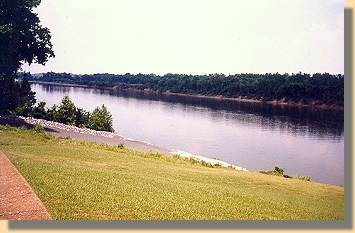
Tennessee River, looking northeast from Pittsburg Landing
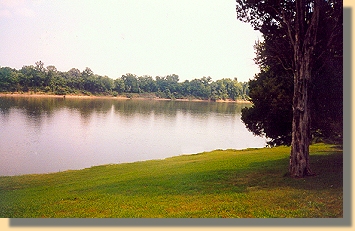
Tennessee River, looking southeast from Pittsburg Landing
Pittsburg Landing was the key to the Union strategy --- a good troop landing
and staging area for an attack on the Southern army at Corinth, a strategic rail
center. But the Confederates struck first, driving the surprised Federals from
their camps back toward the landing.
On Sunday afternoon, thousands of Union stragglers congregated along the banks
here and refused to fight while reports of disaster filtered in from the
battlefield.
Late Sunday afternoon the tide began to turn. Cheers went up when the first
Union reinforcements appeared on the opposite shore. Throughout the night
additional troops poured into the landing by steamboat and by road --- 24,000 in
all. The next morning the revitalized Union forces won back all of the ground
they had lost, and sent the Confederates reeling back to Corinth.
|
|
PAGE TWO
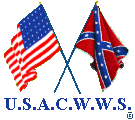 >
Civil War Photos
>
Western Map
>
Shiloh
>
Page 2
>
3
>
4
>
5
>
6
>
7
>
8
>
Civil War Photos
>
Western Map
>
Shiloh
>
Page 2
>
3
>
4
>
5
>
6
>
7
>
8
Notes
|
|



